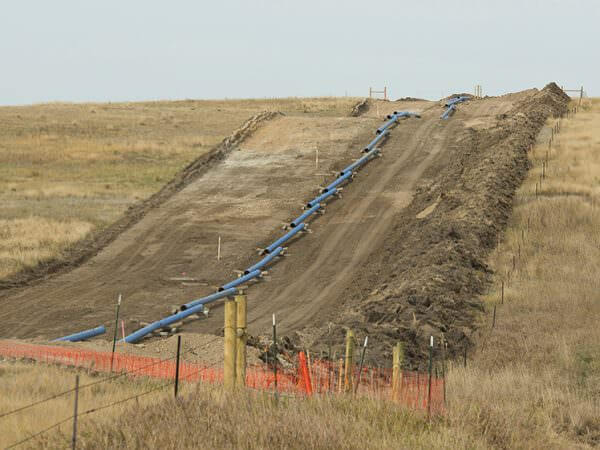
President Trump wasted no time issuing executive orders to move stalled pipeline projects forward: the Dakota Access and Keystone XL. The United States is the No. 1 consumer of oil and boasts the largest pipeline network in the world. Pipelines are lifelines to the American economy and modern way of life. They are an indispensable part of our nation’s energy infrastructure and the safest means of transporting petroleum products. Let’s take a look at the two pipelines and what the President’s executive orders mean for each.
Dakota Access
Dakota Access, a 30-inch-diameter pipeline owned by Energy Transfer Partners, will move up to 570,000 barrels per day from the Bakken oil fields to Patoka, Illinois. It was scheduled to be operational by the end of 2016. All permits, including approval by the U.S. Army Corps of Engineers, were obtained by the company; however, protests, federal intervention and a change in position by the Corps have stopped the pipeline in its tracks.
Self-proclaimed “water protectors” descended upon a protest site last summer near Lake Oahe at the confluence of the Cannonball and Missouri rivers to protest the pipeline crossing a half mile north of the Standing Rock Sioux Indian Reservation. Celebrities and environmental activists have flocked to North Dakota to stop what they believe is an injustice against the Sioux people.
Earthjustice filed a lawsuit on behalf of the Standing Rock Sioux tribe, stating, “The public water supply for the Tribe, which provides drinking water for thousands of people, is located a few miles downstream of the proposed pipeline crossing route.” It argues, “The cultural and religious significance of these waters cannot be overstated. … Construction of the pipeline … would destroy burial grounds, sacred sites and historically significant areas on either side of Lake Oahe.”
Consultation with GeoEngineers, a subcontractor on the Dakota Access Pipeline, provided information concluding that the boring process would not be of a magnitude to impact natural features, cultural resource features or above-ground structures. In a response to the federal order to stop construction on the pipeline, Chairman and CEO of Energy Transfer Partners Kelcy Warren wrote, “Concerns about the pipeline’s impact on the local water supply are unfounded,” and “multiple archaeological studies conducted with state historic preservation offices found no sacred items along the route.” Within the corridor where the Dakota Access line was sited lies an existing natural gas pipeline.
In September, Judge James E. Boasberg of the U.S. District Court denied the tribe’s lawsuit to block pipeline construction, citing a lack of evidence that building the pipeline would harm the tribe or cultural resources. The Judge added that while the tribe had been provided countless opportunities to comment on the proposed route, tribal members did not appear at any of the 141 meetings held by the Dakota Access team.
Immediately following the failed lawsuit, the Department of Justice, Department of the Interior and Army Corps of Engineers announced an indefinite suspension of pipeline construction to reassess cultural impacts to what the tribe calls sacred ground. In the joint statement to halt construction beneath Lake Oahe, it was said that the conflict highlights the need to consider “nationwide reform with respect to considering tribes’ views on these types of infrastructure projects.”
Keystone XL
Across the border, Canadian midstream company TransCanada has been given the go-ahead to resubmit an application for the long-awaited Keystone XL pipeline. Keystone XL is a proposed 36-inch-diameter crude oil pipeline that starts in Hardisty, Alberta, and stretches south to Steele City, Nebraska. It would deliver up to 830,000 barrels of crude oil per day to Gulf Coast refineries and contribute $3.4 billion to the national GDP.
Keystone XL has served as a poster child for needlessly delayed projects under the Obama administration. TransCanada filed the permit more than eight years ago. After a yearslong process, the Keystone XL decision was pushed off indefinitely, in spite of extensive study by Obama’s Department of State. The reason: politics.
In 2014, the Department of State released a report that should have cleared the path to approval of the pipeline. It concluded that the Keystone XL would not substantially impact greenhouse gases. Oil transport by pipeline is, in fact, the least impactful on emissions. Consider the emissions produced by diesel-powered rail or truck transportation.
Had TransCanada been approved for construction three years ago, the pipeline would likely have sailed smoothly through Montana, where the pipeline has already been approved. The Montana Land Board voted unanimously in 2012 to grant rights of way to TransCanada.
Two years ago, the Sioux and Assiniboine tribes of the Fort Peck Reservation passed a resolution opposing the Keystone XL pipeline. Unquestionably, the Dakota Access protest near the Standing Rock Reservation in South Dakota has placed pipeline projects in the crosshairs for opponents. Following the announcement of Trump’s executive orders, protesters warned they’d be out in full force to stop the projects from being built. No doubt the passivism of the Obama administration has empowered activists and opponents of the oil and gas industry.
Like Dakota Access, Keystone XL would cross west of a reservation boundary. The 2015 Fort Peck tribe resolution was the result of concerns that a pipeline failure upstream from Fort Peck Dam could contaminate the entire Missouri River water supply. In North Dakota, similarly, concerns have been voiced over the impact to water in Lake Oahe and the Missouri River, which provide drinking water to the Standing Rock Reservation through an intake located downstream.
The intake for the Montana Assiniboine/Sioux Water Project is on the Fort Peck Reservation off the Missouri River, which borders the reservation on the south side. At the Missouri River, the Keystone XL would be buried 40–60 feet below the riverbed.
Additionally, a TransCanada spokesperson says the company has agreed to 59 special conditions for the project, including the use of flexible, high-strength carbon steel near waterways that can withstand the impact of a 65-ton excavator. The steel TransCanada will use is designed with special features to reduce corrosion.
Both the Keystone XL and Dakota Access pipelines will be utilizing the latest and safest monitoring technologies, including pressure and temperature sensors and automatic shut-off valves. Before any crude moves through either pipeline, they will be required to be hydrotested to ensure their mechanical integrity. Once complete, these pipelines will be monitored 24/7 from a central control station capable of responding within seconds to any pipeline abnormality.
Beyond the protest of the tribes and environmental groups, Keystone XL has earned widespread support from landowners, county commissioners, legislators, Montana’s Governor and congressional delegation. That’s because of the enormous economic impact the pipeline would have, making it a boon for hard-up rural communities.
Under the Obama administration, federal agencies relied upon political gamesmanship and an arbitrary application of the law to shelve projects that would spur the nation’s economy. Many of the decisions and rules made over the last eight years were fueled by an agenda to dismantle the energy industry, an agenda that has made casualties of America’s working class.
Trump’s Move
President Trump’s executive orders regarding the Dakota Access and Keystone XL pipelines — along with his cabinet selection and repeated calls for a regulatory rollback — provide a glimpse into the agenda he campaigned on, an agenda focused on unleashing the country’s energy potential.
While cautiously optimistic, many in the oil and gas industry, from corporate offices to rig floors, are looking forward to the resurrection of a consistent application of the law and predictable energy policies that put boots (and drill bits) back on the ground.
About the author: Jessica Sena is currently under contract with a variety of clients in the natural resource development industry. She has worked with trade associations, namely the Montana Petroleum Association, as well as private companies as an Independent Public Relations and Communications Adviser.
Sena has presented to a variety of industry associations and provided interviews on subjects related to energy policy on a wide array of programs. Her work is regularly featured in regional trade publications on oil and gas. Sena is a Guest Host on the statewide radio program Voices of Montana. She is also a Policy Adviser to the Heartland Institute.














